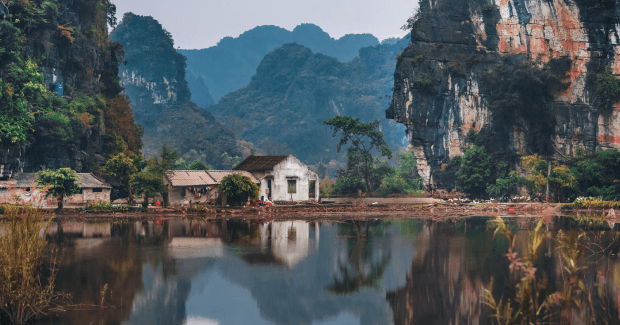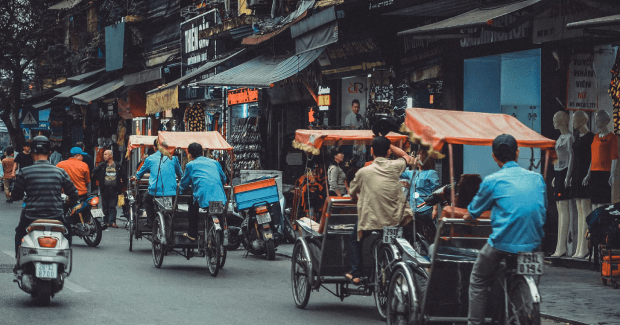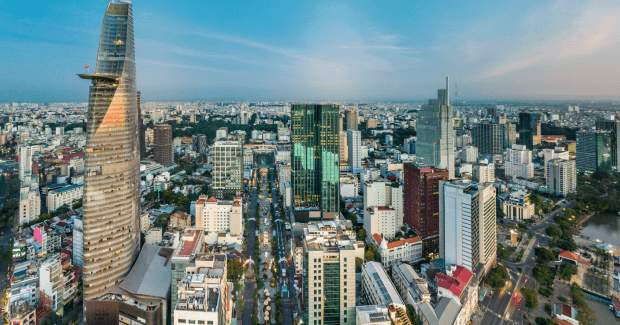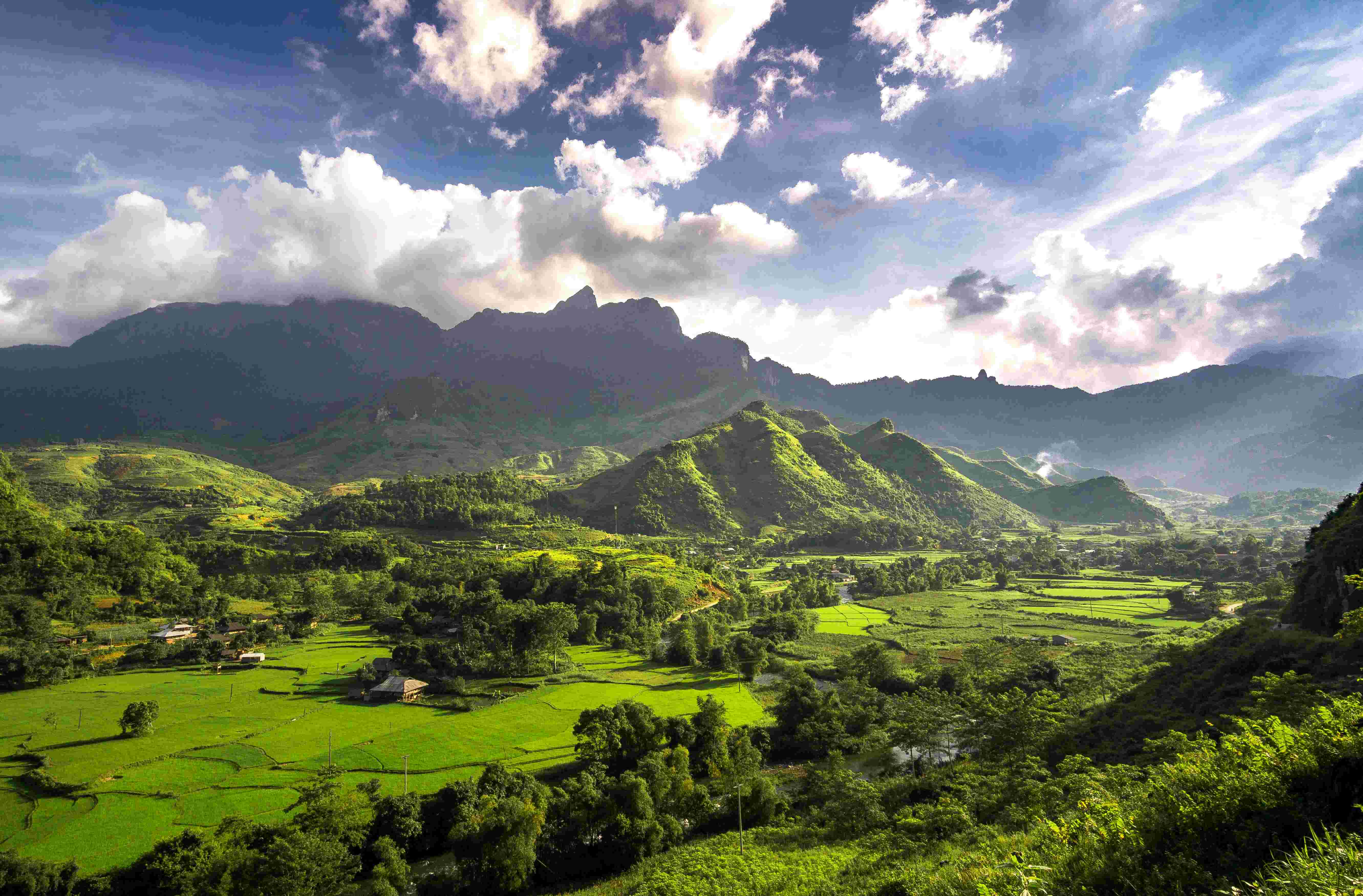Digital Nomad Visa For Vietnam

Quick Visa Facts
Visa length N/A
Possible to extend? N/A
Who can apply? N/A
Minimum Income Requirements N/A
Time for visa applications N/A
Want to know if you can apply?
Complete a visa quiz and see if you qualify!
Quick facts about Vietnam
Vietnam is a dream destination for many backpackers and adventurers. The country is rich in history, packed with stunning landscapes, and has delicious and cheap food options. It attracts many tourists every year, and now thanks to its fast-growing economy it’s becoming an attractive destination for many digital nomads and remote workers.
Vietnam is located in Southeast Asia, bordering China, Laos, and Cambodia. The Vietnamese culture is beautiful. Vietnamese people are kind, friendly, and always open to foreigners. It’s definitely a destination to keep in mind!
Capital Hanoi
Form of Government Communist government
Population 97.24 million (2020)
Climate Tropical climate
Language Vietnamese
Currency Vietnamese Dong (VND)

7 people in Vietnam!
Join the community of remoters!
Living in Vietnam as a digital nomad
Vietnam has experienced a lot of development over the last decade. The main cities look more modern and sophisticated than ever before. You can easily find shopping centers, apartment buildings, and many other amenities, making it easy to get anything that you need as a digital nomad.
There are two big cities in Vietnam, Hanoi and Ho Chi Minh City (also known as Saigon). These are the two main destinations for digital nomads and remote workers coming to work and live from Vietnam.
Living in Vietnam is surprisingly accessible for expats or digital nomads. The cost of living is low, the country has a lot to offer, and it is very easy to travel around Southeast Asia from Vietnam. Additionally, Vietnam is generally a safe country. Pickpocketers are always a risk (as they can be anywhere), but otherwise there is not a lot of crime to concern yourself with.
Attractions and best places to visit
Vietnam has a lot to offer to all of its travelers. The country is known for being a mix of natural highlights and cultural diversity. It has an unbelievable range of beautiful landscapes, from mountain peaks to sunny beaches. Vietnam has something for everyone!

In fact, Vietnam has eight UNESCO heritage sites. One of the most beautiful is the seascape of Halong Bay. There are thousands of limestone islands within this bay in the Gulf of Tonkin, which have been eroded into jagged pinnacles by wind and water. There are also many caves and three mammoth caverns that can be entered through the bay.
If you want to learn about the history of Vietnam, you should head toward Hue. It’s one of the most historic towns in Vietnam, packed with relics from the reign of the 19th-century Nguyen emperors. While visiting Hue you can explore the stunning Ngo Mon Gate, the Thai Hoa Palace, the Dien Tho Residence, and the Halls of Mandarins.
To truly appreciate the beautiful landscapes of Vietnam, then you need to heead towards the Sapa countryside. Here you can find the notorious Vietnamese rice fields. The deep valleys located there are home to a diverse mix of Vietnam’s ethnic minorities, like the Hmong, Giay, and Red Dzao people. You can explore the country’s rich cultural heritage while walking through the rice fields and overlooking the country’s tallest peak, the Fansipan Mountain.
If you’re looking for a beach, Nha Trang is the place for you. This is a well-maintained beach that goes along the shoreline of the center of Nha Trang City. There are designated swimming areas and lounging areas that are perfect for relaxing while enjoying the warm weather.
Digital Nomad Hotspots
There are many smaller cities in Vietnam that are only recently catching the attention of digital nomads thanks in huge part to world of mouth in the nomad community. They are now adapting to the demand by bringing in amenities to suit the digital nomad lifestyle such as coworking spaces and coliving spaces.
Ho Chi Minh City is the political capital of Vietnam and a great place for digital nomads to live. It is the country’s business center, which means you’ll easily find modern conveniences, plenty of co-working spaces, shopping malls, apartment buildings, and more. It’s a very popular city, so it can get busy at times. If you love the city life, then Ho Chi Minh City is perfect for you.
Hanoi is another great destination. Being the capital of Vietnam, it is the second-largest city in the country. Hanoi is quieter than Ho Chi Minh City, but it also offers a high standard lifestyle, with apartments, malls, and other modern conveniences.
For those nomads who crave a slower pace of life in a more remote area Hoi An is a beautiful spot.. It’s a smaller hub for digital nomads, but still a great destination. It’s famous among tourists, because it has a lot of beautiful sites and the old town is a designated UNESCO world heritage site. This town has many afforablde accommodation option and you can also find several coworking spaces.
Da Nang attracts ex-pats and digital nomads because of it’s the largest beach city in Vietnam. It offers affordable housing options, and plenty of restaurants, cafes, and shops. Da Nang is relatively close to Hoi An, just 45 minutes away by car. So you can easily visit both cities.
Cost of Living
The best advantage of living in Vietnam as a digital nomad is the low cost of living. You can comfortably live on $800 per month, but it depends on the city you wish to live at.
You can rent a small apartment in Ho Chi Minh City for $250/month. If you wish to live with a little bit more luxury, you can find an apartment in the city center of Ho Minh City for $800/month.
You can spend from $250-$500 a month for food, transportation, and entertainment. A basic lunch menu costs around $5.
Digital Nomad Essentials
Vietnam is among the countries with the most internet users in the Asia Pacific Region. It comes to no surprise then that in the big cities, you’ll find fast internet everywhere. Plenty of coffee shops, restaurants, and shops offer free Wi-Fi.
Staying connected in Vietnam is inexpensive. The best thing to do is to purchase a SIM card with a mobile data plan. There are plenty of providers with good plans for you to choose from. Viettel offers tourist SIM cards for $5-$10, and you can buy credit to top off. They also have monthly packages on 4G and 3G network.


Our Community Drives it all
Join the community of remoters!
Visa Overview
Vietnam is a great destination for many digital nomads. That said, it does not have a visa available specifically for remote workers. But that doesn’t mean there aren’t options for digital nomads to visit Vietnam for a long period of time.
They have a tourist visa available to many countries, most of whom can stay in the country for 30 days, with the possibility to extend it. The Vietnamese government allows tourists to apply online or on arrival, through a facilitated process.
There are some countries that do not need a visa to enter the country. People from Germany, Italy, Denmark, Finland, France, Spain, and Sweden can enter the country for 15 days without a visa. People from Cambodia, Indonesia, Malaysia, and Singapore can enter the country for 30 days without a visa. You must wait at least 30 days between visits if you want to re-enter Vietnam after you leave. There are other countries that can enter the country without a visa for a specific amount of time. To check the complete list, head towards this website.
If your country is not included in that list, then you can apply for a tourist visa. Keep in mind that you are technically no supposed to be working when you’re on the 30-day tourist visa.
It is also important to remember that there might be some restrictions to travel to Vietnam. Stay up-to-date with COVID-19 entry requirements for Vietnam here.

Our Community Drives it all
Join the community of remoters!
Who Can Apply for the Digital Nomad Visa for Vietnam

Nearly everyone who wishes to enter Vietnam needs to get a Tourist Visa before traveling to the country.
Unless your part of the visa exemptions listed above, then you need to apply for a tourist visa in order to enter Vietnam.
The digital nomad visa for Vietnam is issued for a maximum of 30 days and can be issued for a single entry or for multiple entries.
How to Apply for the Digital Nomad Visa for Vietnam
Thankfully, it is incredibly easy to apply. You can apply online, on arrival, or at an embassy.
Citizens of certain countries are able to submit their application for a Tourist Visa online on this website. In order to apply for a Tourist eVisa, you have to visit the Vietnam Immigration Portal website and start a new application.
If you’re planning to apply upon arrival, keep in mind that visas are only issued at the following ports of entry:
Tan Son Nhat in Ho Chi Minh City
Noi Bai International Airport in Hanoi
Danang Airport in Da Nang
Cat Bi Airport in Hai Phong
Cam Ranh Airport in Nha Trang
The third option is for those that are not eligible for an eVisa, or if you want to have the visa on your passport when you enter Vietnam. You can apply at an Embassy or Consulate of Vietnam near you and send the documents through mail, or go deliver them yourself.
Documents required to apply for the digital nomad visa for Vietnam
In order to apply for the Tourist Visa, you’ll need the following documents:
Passport
Vietnam Visa Application Form.
Letter of Approval (if you’re applying for the Visa upon arrival)
Entry and exit form (you’ll get it on the airplane)
Passport-size pictures
Proof you have paid the Vietnam Visa fee
Any other additional documents that the Vietnam Embassy/Consulate may require
How much does it cost?
The digital nomad visa for Vietnam costs $25 if you’re applying online.
If you’re applying for the visa upon arrival, then a single-entry costs $25. For multiple-entry it costs $50.
If you’re applying for the visa at an Embassy or Consulate, then the price will depend on the specific Embassy or Consulate you’re applying at.

Our Community Drives it all
Join the community of remoters!
Timeline for Applying

The processing time for the digital nomad visa for Vietnam depends on how you’re applying. For the eVisa, it takes around three working days.
If you’re applying upon arrival, it can take between 2 to 4 working days for the Letter of Approval. It can sometimes be more, depending on what company you’re using to request the Letter of Approval.
The processing time on an Embassy or Consulate also depends on the specific Embassy or Consulate you’re applying at.
Curious about what digital nomad visas you qualify for? Enter your details in our Visa Wizard to find out!
Author
Nadia Dardón is a freelance writer from Guatemala. In early 2022 she embarked as a digital nomad, traveling through Europe, focusing mostly on the literary history of each country. She has worked fully remotely for the past four years as a reader, writer, and content creator with experience creating pieces for different industries. She also has a personal blog where she writes about her cultural and literary travels.